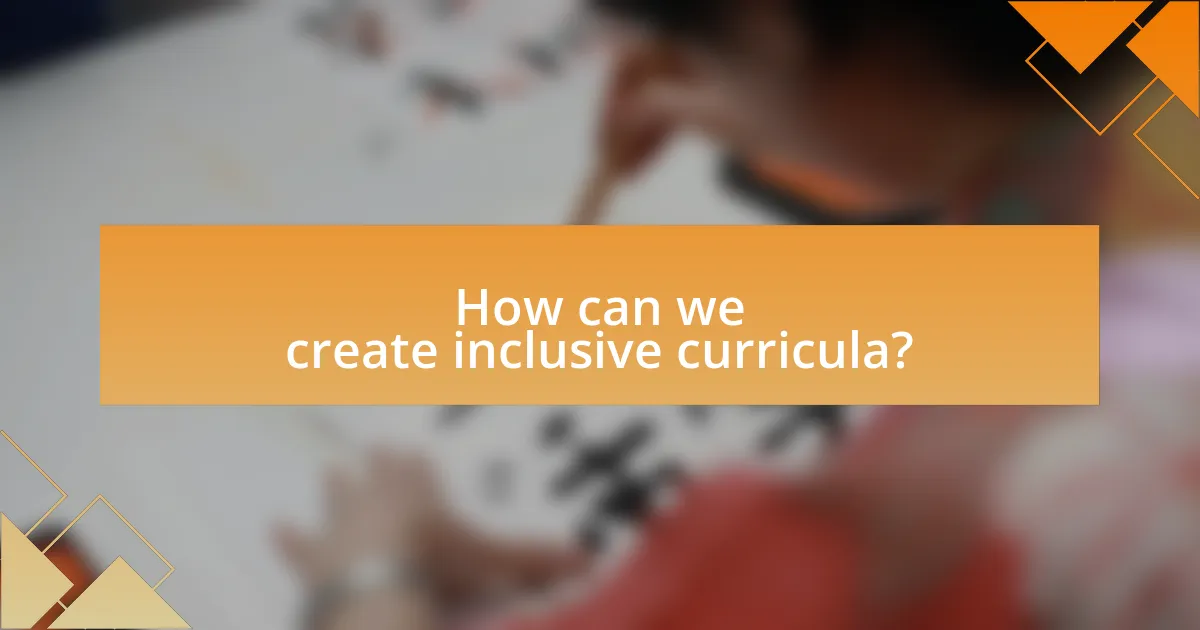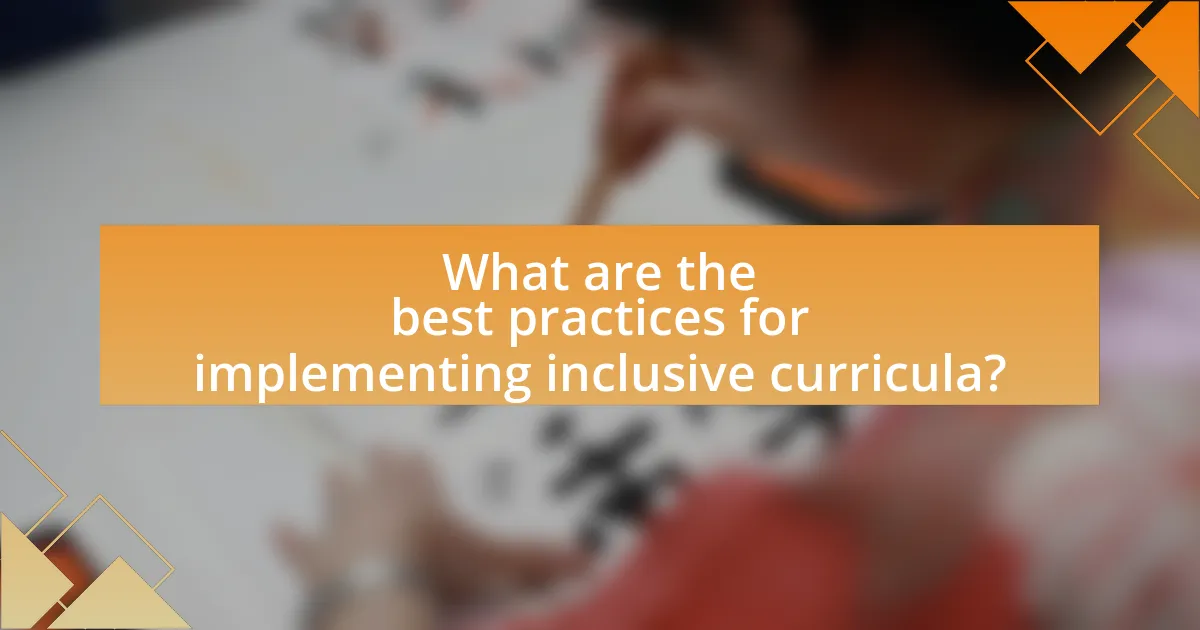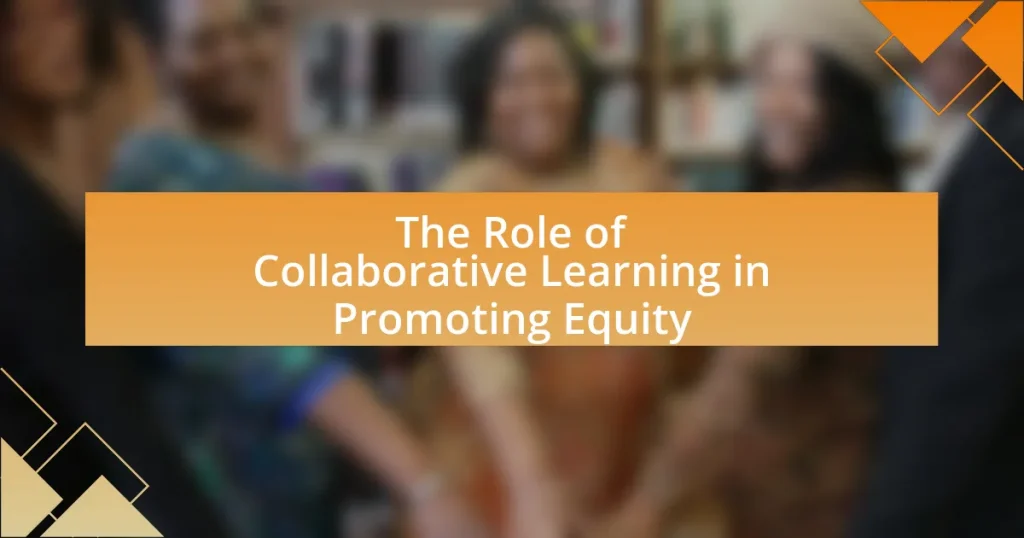Creating inclusive curricula is a vital educational approach that aims to reflect diverse perspectives and experiences, ensuring representation and value for all students. This article explores the significance of inclusivity in education, highlighting its impact on student engagement and academic performance. Key principles such as accessibility, representation, and flexibility are discussed, along with the roles educators and community stakeholders play in fostering inclusivity. The article also outlines practical steps for developing inclusive curricula, addresses challenges faced in implementation, and provides successful examples of inclusive practices in various educational settings.

What is Creating Inclusive Curricula?
Creating inclusive curricula involves designing educational programs that reflect diverse perspectives and experiences, ensuring that all students feel represented and valued. This approach integrates various cultural, social, and historical contexts into the learning material, promoting equity and accessibility in education. Research indicates that inclusive curricula can enhance student engagement and academic performance by fostering a sense of belonging and respect among learners from different backgrounds. For instance, studies show that when students see their identities and experiences reflected in the curriculum, they are more likely to participate actively and achieve better outcomes.
Why is inclusivity important in education?
Inclusivity is important in education because it ensures that all students, regardless of their backgrounds or abilities, have equal access to learning opportunities. Research indicates that inclusive education promotes better academic outcomes, social skills, and emotional well-being among students. For instance, a study published in the “Journal of Special Education” found that inclusive classrooms lead to higher achievement levels for both students with disabilities and their peers, demonstrating that diverse learning environments foster collaboration and mutual respect. By embracing inclusivity, educational institutions can create a more equitable and supportive atmosphere that benefits all learners.
What are the key principles of inclusive curricula?
The key principles of inclusive curricula are accessibility, representation, and flexibility. Accessibility ensures that all students, regardless of their backgrounds or abilities, can engage with the curriculum effectively. Representation involves including diverse perspectives and voices in the content, reflecting the varied experiences of all students. Flexibility allows for different learning styles and paces, accommodating individual needs and promoting equitable learning opportunities. These principles are supported by educational research, which indicates that inclusive curricula enhance student engagement and achievement across diverse populations.
How does inclusivity impact student engagement and learning outcomes?
Inclusivity significantly enhances student engagement and improves learning outcomes. When educational environments embrace inclusivity, students feel valued and respected, which fosters a sense of belonging. Research indicates that inclusive practices, such as diverse curricula and collaborative learning opportunities, lead to higher levels of participation and motivation among students. For instance, a study published in the “Journal of Educational Psychology” found that students in inclusive classrooms demonstrated increased academic performance and engagement compared to those in non-inclusive settings. This correlation underscores the importance of inclusivity in creating effective learning experiences that cater to diverse student needs.
Who benefits from inclusive curricula?
Inclusive curricula benefit all students, educators, and the broader community. Students gain a sense of belonging and engagement, which enhances their learning experiences and academic performance. Research indicates that inclusive curricula improve critical thinking and empathy among students by exposing them to diverse perspectives. Educators benefit by fostering a more dynamic and collaborative classroom environment, which can lead to improved teaching practices. The broader community benefits from producing well-rounded individuals who are better prepared to participate in a diverse society, ultimately promoting social cohesion and understanding.
How does inclusive curricula support diverse student populations?
Inclusive curricula support diverse student populations by providing equitable access to educational content that reflects various cultural, social, and personal identities. This approach fosters a sense of belonging and engagement among students, which is crucial for their academic success. Research indicates that when curricula include diverse perspectives, students demonstrate improved critical thinking skills and higher academic achievement. For instance, a study published in the “Journal of Educational Psychology” found that students exposed to inclusive materials showed a 20% increase in engagement and a 15% improvement in test scores compared to those who learned from traditional, non-inclusive curricula.
What role do educators play in fostering inclusivity?
Educators play a crucial role in fostering inclusivity by creating an environment where all students feel valued and represented. They achieve this by implementing diverse curricula that reflect various cultures, perspectives, and experiences, which enhances students’ understanding and appreciation of diversity. Research indicates that inclusive teaching practices, such as differentiated instruction and culturally responsive pedagogy, lead to improved academic outcomes and social-emotional development for all students. For instance, a study published in the “Journal of Educational Psychology” found that students in inclusive classrooms demonstrated higher levels of engagement and motivation. Thus, educators are essential in promoting inclusivity through thoughtful curriculum design and teaching strategies that embrace diversity.

How can we create inclusive curricula?
To create inclusive curricula, educational institutions must integrate diverse perspectives and experiences into the learning materials and teaching methods. This can be achieved by conducting thorough research on the demographics of the student body and incorporating content that reflects various cultures, histories, and viewpoints. For instance, studies show that curricula that include multicultural education can enhance student engagement and academic performance, as evidenced by the research conducted by Banks and Banks in “Multicultural Education: Issues and Perspectives,” which highlights the positive impact of inclusive teaching practices on student outcomes. Additionally, involving students, parents, and community members in the curriculum development process ensures that multiple voices are heard and represented, fostering a sense of belonging and respect among all learners.
What steps are involved in developing an inclusive curriculum?
Developing an inclusive curriculum involves several key steps: conducting a needs assessment, engaging diverse stakeholders, designing curriculum content, implementing inclusive teaching strategies, and evaluating effectiveness.
First, conducting a needs assessment identifies the specific needs of diverse learners, ensuring that the curriculum addresses various backgrounds and learning styles. Engaging diverse stakeholders, including students, parents, and community members, fosters a collaborative approach that reflects multiple perspectives. Designing curriculum content requires integrating diverse voices and perspectives, ensuring representation of various cultures, histories, and experiences. Implementing inclusive teaching strategies, such as differentiated instruction and culturally responsive pedagogy, supports all learners in accessing the curriculum. Finally, evaluating effectiveness through feedback and assessment data allows for continuous improvement and adaptation of the curriculum to meet the needs of all students.
These steps are supported by research indicating that inclusive curricula enhance student engagement and achievement across diverse populations.
How can educators assess the current inclusivity of their curricula?
Educators can assess the current inclusivity of their curricula by conducting a comprehensive review of course materials, teaching practices, and student feedback. This assessment involves analyzing the representation of diverse perspectives, cultures, and identities within the curriculum content. Research indicates that inclusive curricula enhance student engagement and learning outcomes; for instance, a study by the National Education Association found that students exposed to diverse materials showed improved critical thinking skills and academic performance. Additionally, educators can utilize surveys and focus groups to gather insights from students about their experiences and perceptions of inclusivity in the classroom. This data-driven approach ensures that curricula reflect the diverse voices and experiences of all students, fostering an equitable learning environment.
What resources are available for creating inclusive educational materials?
Resources available for creating inclusive educational materials include guidelines from organizations such as the National Center on Universal Design for Learning, which provides frameworks for designing accessible learning experiences. Additionally, the Inclusive Design Research Centre offers tools and resources that focus on the needs of diverse learners. Research from the American Educational Research Association highlights the importance of culturally responsive teaching materials that reflect the backgrounds and experiences of all students. Furthermore, platforms like Teaching Tolerance provide lesson plans and resources aimed at promoting equity and inclusion in the classroom. These resources collectively support educators in developing materials that cater to a wide range of learning needs and backgrounds.
What challenges might arise in creating inclusive curricula?
Creating inclusive curricula faces several challenges, including resistance to change, lack of resources, and insufficient training for educators. Resistance to change often stems from established educational practices and beliefs that may not prioritize inclusivity. Additionally, many educational institutions may lack the financial and material resources necessary to develop and implement inclusive curricula effectively. Furthermore, educators may not receive adequate training on inclusive teaching strategies, which can hinder their ability to create an environment that supports diverse learning needs. These challenges highlight the complexities involved in ensuring that all voices are represented in education.
How can educators address resistance to inclusivity in the classroom?
Educators can address resistance to inclusivity in the classroom by fostering open dialogue and providing professional development on inclusive practices. Open dialogue allows students and staff to express concerns and misconceptions, creating a safe space for discussion. Professional development equips educators with strategies to implement inclusive curricula effectively, which has been shown to improve student engagement and academic performance. Research indicates that schools with comprehensive training on inclusivity see a 30% increase in positive student outcomes, demonstrating the effectiveness of these approaches.
What strategies can be employed to overcome resource limitations?
To overcome resource limitations in creating inclusive curricula, educational institutions can implement strategies such as leveraging community partnerships, utilizing digital resources, and adopting flexible funding models. Community partnerships can provide additional support and resources, as evidenced by programs where local organizations contribute materials and expertise, enhancing curriculum development. Utilizing digital resources, such as open educational resources (OER), allows educators to access high-quality materials at no cost, which has been shown to improve educational outcomes while reducing expenses. Additionally, adopting flexible funding models, such as grants and crowdfunding, can help secure necessary resources, as demonstrated by various successful initiatives that have funded inclusive educational projects through community engagement and support.

What are the best practices for implementing inclusive curricula?
The best practices for implementing inclusive curricula include integrating diverse perspectives, utilizing culturally relevant materials, and fostering an inclusive classroom environment. Integrating diverse perspectives ensures that students from various backgrounds see themselves represented in the curriculum, which enhances engagement and learning outcomes. Utilizing culturally relevant materials involves selecting texts and resources that reflect the experiences and histories of all students, thereby promoting equity in education. Fostering an inclusive classroom environment requires educators to create a safe space where all students feel valued and respected, which can be achieved through collaborative learning and open dialogue. Research indicates that inclusive curricula lead to improved academic performance and social-emotional development among students, as highlighted in the study “The Impact of Culturally Relevant Pedagogy on Student Engagement” by Ladson-Billings (1995).
How can collaboration enhance the development of inclusive curricula?
Collaboration enhances the development of inclusive curricula by integrating diverse perspectives and expertise, which leads to more comprehensive educational content. When educators, community members, and stakeholders work together, they can identify and address the unique needs of various student populations, ensuring that the curriculum reflects a wide range of experiences and backgrounds. Research indicates that collaborative curriculum development can improve student engagement and learning outcomes, as it fosters an environment where all voices are heard and valued. For instance, a study by the National Education Association found that inclusive curricula developed through collaboration can significantly increase student participation and achievement, particularly among marginalized groups.
What role do community stakeholders play in curriculum inclusivity?
Community stakeholders play a crucial role in curriculum inclusivity by providing diverse perspectives and resources that reflect the needs and values of the community. Their involvement ensures that the curriculum is relevant and representative of various cultural, social, and economic backgrounds. For instance, research indicates that when schools engage parents, local organizations, and cultural groups in curriculum development, students demonstrate improved engagement and academic performance. This collaborative approach fosters a sense of belonging and respect for diversity, which is essential for creating an inclusive educational environment.
How can feedback from students improve curriculum inclusivity?
Feedback from students can significantly improve curriculum inclusivity by providing insights into diverse learning needs and experiences. When students share their perspectives, educators can identify gaps in representation and adjust course materials to reflect a broader range of voices and viewpoints. Research indicates that inclusive curricula enhance student engagement and academic performance, as evidenced by a study published in the “Journal of Educational Psychology,” which found that students who felt represented in their curriculum were more likely to participate actively in class discussions. By systematically collecting and analyzing student feedback, educational institutions can create a more equitable learning environment that acknowledges and values the contributions of all students.
What are some successful examples of inclusive curricula?
Successful examples of inclusive curricula include the “Culturally Relevant Pedagogy” framework developed by Gloria Ladson-Billings, which emphasizes the importance of incorporating students’ cultural references in all aspects of learning. This approach has been implemented in various schools across the United States, resulting in improved student engagement and academic performance, particularly among marginalized groups. Another example is the “Universal Design for Learning” (UDL) framework, which provides multiple means of engagement, representation, and action/expression to accommodate diverse learners. Research shows that schools adopting UDL principles have seen increased participation and achievement among students with disabilities. Additionally, the “Social Justice Education” curriculum, which focuses on equity and inclusion, has been successfully integrated into various educational settings, fostering critical thinking and awareness of social issues among students. These curricula demonstrate effective strategies for ensuring that all voices are represented in education.
How have specific schools or districts implemented inclusive practices?
Specific schools and districts have implemented inclusive practices by adopting Universal Design for Learning (UDL) frameworks, which provide multiple means of engagement, representation, and action for all students. For example, the Montgomery County Public Schools in Maryland have integrated UDL principles into their curriculum, allowing teachers to tailor lessons to diverse learning needs, thereby improving accessibility for students with disabilities. Additionally, the Los Angeles Unified School District has established inclusive classrooms that promote collaboration among students of varying abilities, supported by training for educators on differentiated instruction techniques. These initiatives demonstrate a commitment to fostering an educational environment where all voices are represented and valued.
What lessons can be learned from successful inclusive curriculum initiatives?
Successful inclusive curriculum initiatives demonstrate the importance of collaboration among educators, students, and communities to create a learning environment that values diverse perspectives. These initiatives show that integrating multiple viewpoints enhances critical thinking and fosters a sense of belonging among all students. For instance, research by the National Center for Learning Disabilities indicates that inclusive curricula lead to improved academic outcomes and social skills for students with and without disabilities. Additionally, successful initiatives highlight the need for ongoing professional development for educators to effectively implement inclusive practices, ensuring they are equipped to address the varied needs of their students.
What practical tips can educators use to ensure inclusivity in their curricula?
Educators can ensure inclusivity in their curricula by incorporating diverse perspectives and materials that reflect various cultures, identities, and experiences. This can be achieved by selecting texts and resources from authors of different backgrounds, ensuring representation of marginalized groups, and integrating multicultural education into lesson plans. Research indicates that inclusive curricula enhance student engagement and learning outcomes, as they foster a sense of belonging and validation among all students. For example, a study by the American Educational Research Association found that students exposed to diverse curricula showed improved critical thinking skills and greater empathy towards others.



